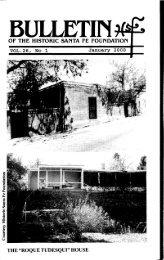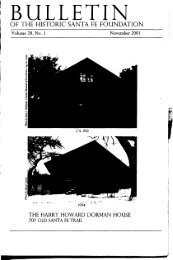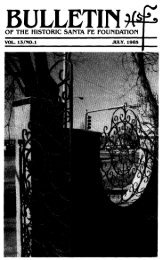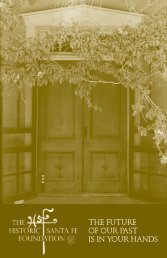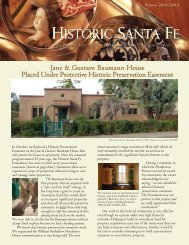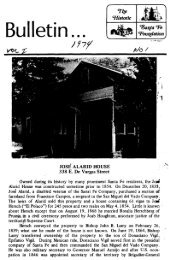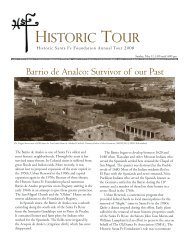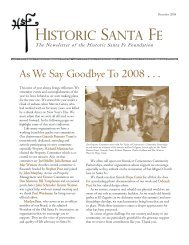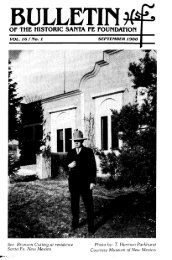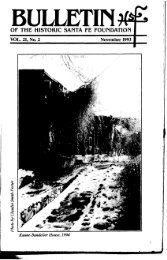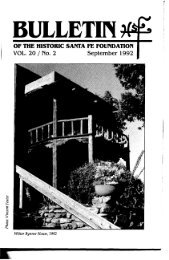A. M. Bergere House - Historic Santa Fe Foundation
A. M. Bergere House - Historic Santa Fe Foundation
A. M. Bergere House - Historic Santa Fe Foundation
You also want an ePaper? Increase the reach of your titles
YUMPU automatically turns print PDFs into web optimized ePapers that Google loves.
Bulletin ...<br />
Vol. 2 Fall - Winter 1976 No.2<br />
THE A; M. BERGERE<br />
135 Grant Avenue<br />
HOUSE<br />
Cultural Properties Review Committee<br />
State Planning Office Files, State Records Center and Archives,<br />
<strong>Santa</strong> <strong>Fe</strong>, New Mexico
·..<br />
fort Marcy Military Reservation.<br />
I SaftI"<br />
- _.~-..--..-.---- r. ,Now H•• ico.<br />
..-----;-r--....<br />
: I '"-'•.•••.. 1<br />
I, .- I ~ .<br />
...l!- -----...<br />
Str:•••t -<br />
7.'<br />
I<br />
•:2<br />
C.J<br />
-<<br />
>-<br />
--<br />
l-<br />
--<br />
Structure _ 13 is today the A. M. 8ergere <strong>House</strong> while _ 16 is the'<br />
Fort Marcy Officer's Residence (Hewett <strong>House</strong>).<br />
<strong>Historic</strong>al Map Collection, State Records Center and Archives,<br />
<strong>Santa</strong> <strong>Fe</strong>, New Mexico<br />
THE A. M. BERGERE HOUSE<br />
135 Grant Avenue<br />
Constructed in the early 1870's as an officer's quarters on the<br />
Fort Marcy Military Reservation, the A. M. <strong>Bergere</strong> <strong>House</strong> has held<br />
a prominent position in the social and military history of New Mexico.
The A. M. Remere <strong>House</strong> on extreme left as it appeared in 1873.<br />
On August 18, 1846, Brigadier-General Stephen Watts Kearny<br />
accepted the peaceful surrender of New Mexico from Acting Governor<br />
Juan Bautista Vigil y Alarid. The following day, Kearny ordered lieutenants<br />
William H. Emory and Jeremy F. Gilmer to reconnoiter <strong>Santa</strong><br />
<strong>Fe</strong> for a location suitable for the construction of a fort ..A site northeast<br />
of the town was quickly selected and an adobe fort named for Secretary<br />
of War William L. Marcy was built. Buildings north of the Palace of<br />
the Governors which were used earlier to house troops during both the<br />
Spanish and Mexican periods were also utilized by the Army of Occupation.<br />
These structures were bounded by Grant Avenue on the west,<br />
<strong>Fe</strong>deral Place on the north, Washington Avenue on the east and Palace<br />
Avenue on the south.<br />
After U.S. authority had been firmly established in New Mexico,<br />
Fort Marcy on the hill was abandoned and Fort Marcy Military Reservation<br />
consisting of about 17 acres was created by President Andrew<br />
Johnson's Executive Order of August 28, 1868. This reservation incorporated<br />
the earlier Spanish and Mexican military quarters which<br />
were subsequently razed and replaced by new and larger military structures.<br />
Quarters for the commanding officer were established north of<br />
the Palace of the Governors and fronting Washington Avenue where the<br />
<strong>Santa</strong> <strong>Fe</strong> National Bank is now located. Six other adobe houses for<br />
officers of lesser rank and their families were also constructed utilizing<br />
a modification of the U.S. Army's standard "Plan C." These six homes<br />
consisting of two-story buildings with cross-gable roofs were symmetrically<br />
positioned with half facing Grant Avenue. Of these six structures,<br />
only the <strong>Bergere</strong> <strong>House</strong> at the northwestern corner and the Fort Marcy<br />
Officer's Residence (commonly known as the Edgar Lee Hewett <strong>House</strong>)<br />
and situated at the southeastern corner have survived.
The activities at Fort Marcy Military Reservation were somewhat<br />
limited and consisted mainly of presenting band concerts and firing<br />
gun salutes for such occasions as the misnamed "Tertio-Millenial Celebration<br />
of 1882." One of the few highlights in the post's history was<br />
the visit of General and former President Ulysses S. Grant, Mrs. Grant<br />
and Mrs. Fred Grant during July of 1880. The distinguished party<br />
visited both Las Vegas and <strong>Santa</strong> <strong>Fe</strong> and while in the capital city, was<br />
furnished quarters in the <strong>Bergere</strong> <strong>House</strong> by the military!<br />
With little apparent need for the post, the Army abandoned Fort<br />
Marcy Military Reservation on October 10, 1894 and the post "was by<br />
Executive Order of June 15, 1895, placed under the custody of the<br />
Interior Department for disposal under the Act of July 5, 1884, being<br />
'An Act to Provide for the disposal of abandoned and useless military<br />
reservations,' .... " Until disposal could be accomplished, the property<br />
was to be administered by the Governor of New Mexico in his capacity<br />
as Custodian of the Fort Marcy Abandoned Military Reservation.<br />
During this period, the six officers' quarters were utilized by politicians<br />
and prominent New Mexicans as rent free residences. On June 3,<br />
1899, Solomon Luna was granted permission to occupy the Berger~<br />
<strong>House</strong>. Whether he and his wife ever lived in the house is not known<br />
since Luna also maintained a large home at Los Lunas at this time.<br />
Possibly, the structure was acquired only for his mother, Isabel Baca de<br />
........
Solomon Luna, son of merchant-farmer Jose Antonio Luna and<br />
his wife Isabel Baca, was a direct descendant of Domingo de Luna who<br />
settled in the Los Lunas area shortly after the Reconquest of New<br />
Mexico in 1693 by General Diego de Vargas Zapata Lujin Ponce de<br />
Leon. Solomon, in addition to being a wealthy sheep raiser and president<br />
of the Bank of Commerce in Albuquerque, also held various important<br />
political offices including that of Valencia County probate<br />
clerk in 1885, sheriff in 1892 and treasurer in 1894. He was the most<br />
influential delegate serving in the Constitutional Convention of 1910.<br />
From 1896 until his death in 1912 he was a member of the National<br />
Republican Committee. His wife, Adelaida Otero de Luna, was the<br />
daughter of Manuel Rito Otero and the granddaughter of Antonio Jose<br />
Otero who was appointed as a justice of the New Mexico Supreme<br />
Court by Kearny.<br />
The Lunas, Oteros and Chaveses were the three most influential<br />
and politically powerful families of the Rio Abajo (lower river) region<br />
during the Mexican and Territorial period. In addition to Solomon, the<br />
familiy also included Tranquilino, Jesus Maria, Luz and Eloisa. Jesus<br />
Maria was a captain in the New Mexico Militia, an Indian fighter and<br />
politician while his other brother Tranquilino engaged in sheep raising<br />
and was also politically active. He was delegate to the Republican<br />
National Conventions in 1880 and 1884; elected as a Republican to the<br />
47th Congress (March 4, I 881-March 3, 1883); presented credentials<br />
as a Delegate-elect to the 48th Congress and served from March 4, 1883<br />
until March 5, 1884, when he was succeeded by Francisco A. Manzanares,<br />
who contested his election; and sheriff of Valencia County<br />
1888-1892. Tranquilino had one son, Maximiliano, who was a captain<br />
of Troop F 1st U.S. Vol. Cav. during the Spanish-American War and<br />
later drowned while serving in the Philippines.<br />
Solomon's sister Luz married Jose Maria Romero while a second<br />
sister, Eloisa, married Manuel B. Otero in 1879. The nephew of previously<br />
mentioned Judge Antonio Jose Otero, Manuel B. Otero was a<br />
prominent rancher in the Los Lunas Area. At Estancia Springs in the<br />
summer of 1883, he was shot and killed by James G. Whitney in a<br />
dispute over a land grant.<br />
The Otero-Luna marriage produced three children: Eduardo<br />
Manuel, prominent sheep raiser and politician; Adelina Isabel Emilia,<br />
superintendent of schools in <strong>Santa</strong> <strong>Fe</strong> County, candidate for Congress<br />
in 1922 and later an inspector at large for the Department of the Interior;<br />
and Manuel Basilio, Republican candidate for governor in 1924.
On August 15, 1886, three years after the death of her husband,<br />
Eloisa Luna Otero married Alfred Maurice <strong>Bergere</strong>. Born in Liverpool,<br />
England on October 10, 1859, <strong>Bergere</strong> was the son of Joseph Charles<br />
and Nina <strong>Bergere</strong> who were both of Italian ancestry. His father was the<br />
owner and builder of the first line of steamships sailing from Liverpool<br />
to the Mediterranean Sea. Alfred <strong>Bergere</strong> immigrated to the United<br />
States in 1872 and six years later moved to Valencia County where he<br />
was involved in mercantile, stock raising and insurance interests. A<br />
Republican, he also exhibited a keen interest in public affairs and served<br />
as chairman of the board of county commissioners fqr two years,<br />
county assessor for two years and county treasurer for six years.<br />
In 1898 with the appointment of John R. McFie as judge of the<br />
first judicial district, <strong>Bergere</strong> became clerk of the district court and the<br />
family moved to <strong>Santa</strong> <strong>Fe</strong>. He held this position until his resignation<br />
in July of 1907. <strong>Bergere</strong>, who was at one time Register and Receiver<br />
of the U.S. Land Office, also served as secretary to U.S. Congressman<br />
Benigno Cardenas Hernandez who was representative at large from New<br />
Mexico (1915 to 1917 and again from 1919 to 1921). An accomplished<br />
musician, <strong>Bergere</strong> was active in the Knights of Columbus and during<br />
World War I, he traveled to France to perform with the Knights who<br />
provided entertainment for American Servicemen. Physically disqualified<br />
from serving in the earlier Spanish-American War, <strong>Bergere</strong><br />
had offered to donate a hundred horses from his ranch at Galisteo to<br />
the United States Government.<br />
OriJinal military fireplace in the A. M. <strong>Bergere</strong> <strong>House</strong>.<br />
Cultural Properties Review Committee<br />
State Planning Office_Files,~tat~ Rec.ords Center and Archives,
Nine children resulted from the marriage of Eloisa and Alfred<br />
<strong>Bergere</strong>: Anita Isabel Eloisa; Elvira Estella, who married Aldo Leopold;<br />
Mary Bernadita, who married John J. Kenney; Antonio Jose Luna;<br />
Maria Eduvigen Consuelo, who married Herbert Mendenhall; Maria<br />
Rosina, who married Leonard Smith; Maria Nestora Christina Ysabel;<br />
Joseph Charles; and Maria Dolores <strong>Bergere</strong>, who married Charles Carl<br />
Leopold.<br />
On <strong>Fe</strong>bruary 28, 190 I, the Secretary of the Interior authorized<br />
Governor and Custodian Miguel A. Otero (Governor of New Mexico<br />
1897-1906) to permit <strong>Bergere</strong> and his family to occupy a building on<br />
the Fort Marcy Abandoned Military Reservation as soon as one became<br />
available. In a letter dated May 4, of the same year, Governor Otero<br />
informed Binger Hermann, of the Dept. of the Interior that no houses<br />
were vacant but that A. M. <strong>Bergere</strong> was occupying the house assigned<br />
to his brother-in-law Solomon Luna. The <strong>Bergere</strong> <strong>House</strong> was the center<br />
for many social events in <strong>Santa</strong> <strong>Fe</strong>. For instance, on one occasion, the<br />
<strong>Bergere</strong>s gave a dinner party in honor of Governor Otero and his wife<br />
which was attended by former Governor L. Bradford Prince and Mrs.<br />
Prince, Captain and Mrs. Maximiliano Luna, as well as important<br />
attorneys and their wives.<br />
On January 5, 1904, the Fort Marey Abandoned Military Reservation<br />
was conveyed to the City of <strong>Santa</strong> <strong>Fe</strong> which in turn transferred<br />
the property to the <strong>Santa</strong> <strong>Fe</strong> Board of Education on the 9th of the<br />
following month. Eloisa purchased the house and the two lots from the<br />
board of education on December 22, 1905 for $2,700. On October 29,<br />
1912, Eloisa conveyed the property in trust to her son Eduardo Manuel<br />
Otero and after a brief illness, died on September 3, 1914. Alfred<br />
<strong>Bergere</strong> continued to live in the house until his own death on May 26,<br />
1939. In 1932, Manuel Basilio Otero was placed in charge of the property<br />
and after his death in 1963, Nina Otero Warren (Adelina Isabel<br />
Emilia) administered the estate until her own death two years later.<br />
Anita <strong>Bergere</strong> (Anita Ysabel Eloisa) and May Kenney (Mary Bernadita<br />
<strong>Bergere</strong>) lived in the residence up to the time of their deaths within<br />
the last year.<br />
At the time of construction, the A. M. <strong>Bergere</strong> <strong>House</strong> formed an<br />
"L" shaped structure having a cross gabled tin-pleated roof crowned<br />
with three ftred brick chimneys. The exterior walls were adobe plastered<br />
and the two front corners were rectangularly etched to simulate dressed<br />
stone corner trim. A full porch supported by eight squared beams and<br />
having a wooden floor and decorative railing was situated on the front<br />
of the building, while an "L" shaped porch of similar construction,<br />
minus the railing, ran along the rear of the house. The original building
Marble frreplace in the A. M. <strong>Bergere</strong> <strong>House</strong>. Three such frreplaces were<br />
moved from Solomon Luna's house in Los Lunas.<br />
Cultural Properties Review Committee<br />
State Planning Office Files, State Records Center and Archives,<br />
<strong>Santa</strong> <strong>Fe</strong>, New Mexico<br />
also contained eighteen double hung windows with dark green shutters.<br />
The front door was framed with panels containing fourteen panes of<br />
glass and has not been altered. Four solid doors existed in the original<br />
structure and provided access to the rear porch from the southeastern<br />
corner room as well as the eastern wing or kitchen. Adjacent to the east<br />
wall of the kitchen were two small rooms which were most likely used<br />
as storerooms. The exterior of the A. M. <strong>Bergere</strong> <strong>House</strong> has been altered<br />
over the years. The cross-gabled roof on the main portion of the house<br />
was removed in 1926 and the upper story was squared and a flat roof<br />
added to make the structure conform to the Spanish-Pueblo style of<br />
architecture which was then experiencing a revival in the capital city.<br />
One result of this modification was the creation of five large bedrooms<br />
on the second floor. A new front porch as well as first floor windows,<br />
consisting of four large rectangular panes of glass and replacing the<br />
earlier twelve pane windows, were installed at this time. A sun room<br />
was added to the south and several small utility rooms and a bathroom<br />
.were added on the east side of the structure where originally the rear<br />
porqh was located. The small storage sheds were likewise modified in<br />
Spanish-Pueblo style and a single car garage was added to the east. The<br />
stables and tennis court constructed by <strong>Bergere</strong> no longer exist but the
Having a central hallway, the interior of the A. M. <strong>Bergere</strong> <strong>House</strong><br />
has been somewhat altered. Of the original four wooden military<br />
fireplaces in the main portion of the house, only one is extant. Three<br />
marble fireplaces from Solomon Luna's home at Los Lunas have replaced<br />
the earlier military ones. A fifth fireplace in the original kitchen, which<br />
was converted into a master bedroom by the <strong>Bergere</strong>s and reused as a<br />
kitchen by their children, has been removed. Throughout the house<br />
hardwood flooring has been placed directly on the wooden plank<br />
flooring. However, much of the original interior door and window trim<br />
are still in place as well as some of the interior doors and accompanying<br />
hardware. The staircase situated in the central hallway has not been<br />
altered.<br />
Located in downtown <strong>Santa</strong> <strong>Fe</strong>, the A. M. <strong>Bergere</strong> <strong>House</strong> has<br />
retained much of its original environment and as one of two surviving<br />
Fort Marcy Military Reservation officer's residences in addition to<br />
being the home of a politically and socially prominent New Mexico<br />
family is worthy of preservation.<br />
James H. Purdy<br />
October 7, 1976<br />
Original military stairway in the A. M. <strong>Bergere</strong> <strong>House</strong>.<br />
Cultural Properties Review Committee<br />
State Planning Office Files, State Records Center and Archives,<br />
(:',. •• ".•.• J:ln 1tt..lnut 1.1",_;,.",
Sources:<br />
Governors' Papers, Miguel A. Otero, 1897-1906. State 'Records Center<br />
and Archives, 404 Montezuma, <strong>Santa</strong> <strong>Fe</strong>, New Mexico.<br />
Frank McNitt Collection, State Records Center and Archives, 404<br />
Montezuma, <strong>Santa</strong> <strong>Fe</strong>, New Mexico.<br />
WPA Files, State Records Center and Archives, 404 Montezuma,<br />
<strong>Santa</strong> <strong>Fe</strong>, New Mexico.<br />
J. J. Stoner's, Bird's Eye View of the City of <strong>Santa</strong> <strong>Fe</strong>, N.M., 1882<br />
(map) State Records Center and Archives, 404 Montezuma, <strong>Santa</strong><br />
<strong>Fe</strong>, New Mexico.<br />
"Headquarters Military District of New Mexico," reproduced from<br />
Rlustrated New Mexico by Wm. G. Ritch, State Records Center<br />
and Archives, 404 Montezuma, <strong>Santa</strong> <strong>Fe</strong>, New Mexico.<br />
Deed Book M-I, pp. 261 & 263 and L-I, p. 234. <strong>Santa</strong> <strong>Fe</strong> County<br />
Clerk's Office.<br />
Book C of Contracts, p. 262, <strong>Santa</strong> <strong>Fe</strong> County Clerk's Office.<br />
Interview of Mrs. May Kenney and Miss Anita <strong>Bergere</strong> by James H.<br />
Purdy at 135 Grant Avenue on May 7, 1974.<br />
<strong>Santa</strong> <strong>Fe</strong> New Mexican, July 19,1880; July 29,1907.<br />
Frazer, Robert W. Forts of the West. Norman: University of Oklahoma<br />
Press, 1965.<br />
Otero, Miguel Antonio. My Nine Years as Governor of the Territory<br />
of New Mexico 1897-1906. Albuquerque: The University of New<br />
Mexico Press, 1940.<br />
Twitchell, Ralph Emerson. Old <strong>Santa</strong> <strong>Fe</strong>. Chicago: The Rio Grande<br />
Press, Inc., 1963 reprint.<br />
____ .. The Leading Facts of New Mexican History, Vol. 3 and 4,<br />
Cedar Rapids: The Torch Press, 1917.<br />
Anderson, George B. (comp.). History of New Mexico, Its Resources<br />
and People, Vol. I, New York: Pacific States Publishing Company,<br />
1907.<br />
Dunne, Brian Born. "Necrology, Alfred M. <strong>Bergere</strong>," New Mexico<br />
<strong>Historic</strong>al Review (July, 1939), pp. 300-303.<br />
Westermeier, Clifford P. "Teddy's Terrors: The New Mexican Volunteers<br />
of 1898," New Mexico <strong>Historic</strong>al Review (April, 1952), p. Ill.
HISTORIC<br />
SANTA FE CARDS<br />
~ ..I' ....<br />
"<br />
I<br />
Note cards of five historical buildings in <strong>Santa</strong> <strong>Fe</strong> are on sale at various local<br />
shops. A percentage of the profit from the sale of these cards goes toward the<br />
Tully <strong>House</strong> Fund. Geus many boxes of card •• s you can - at only $1.50/box.<br />
It is an easy way to help in "Funding" the Tully <strong>House</strong> project. Available<br />
wherever fine cards are sold or call Mrs. Gilliland at 983-8576.<br />
Membership in the <strong>Historic</strong> <strong>Santa</strong> <strong>Fe</strong> <strong>Foundation</strong> is a<br />
significant contribution to the preservation of <strong>Santa</strong> <strong>Fe</strong>'s<br />
heritage.<br />
Be a member!<br />
TERMS TO KNOW IN HISTORIC<br />
SANTA FE<br />
fanega. Measure of wheat and other grain<br />
equivalent to I ~-2~ bushels.<br />
ayuntamiento.<br />
A town council.<br />
garita. A sentry<br />
box or tower.<br />
presidio. Permanent garrison of soldiers.<br />
Old <strong>Santa</strong> <strong>Fe</strong> Today<br />
University of New Mexico Press and<br />
"'("1.,0 U~~+"",..1",~n .•••• +f"ll 00 D •..•. n .•••• A6'to+~n..•.•.
The "Oldest <strong>House</strong>" today.<br />
T"'L_ TT __ 1 TT '- .••.__ •.•. ....1..••..•..•..•..•.<br />
~_ Ell" C',., .•..•I-n 1;0 T,..An1J<br />
SANTA FE YESTERDAY<br />
AND TODAY<br />
:..t •._ ~". l.. - __ l...~~.~ .<br />
",,:, ..•... -.'- ~-;:::::~::..~.. ',.., ,'..,..<br />
I ". '''-~'''''-''_ ••.• _ ~_<br />
The "Oldest <strong>House</strong>" at 215 East de Vargas Street as it appeared in<br />
Harper s Weekly on November 13, 1879.
DONNA E. QUASTHOFF • ARCHITECT<br />
A'l:IM.£R or:; XHE AMERle",.. INSTITUTE or ARCHITECT.<br />
P. D. BOX 2145 • Tj::LEPHONt; 505983-8256 • SANTA rE. NEW MEXICO a7SCl<br />
October 25, 1976<br />
~vh A Associates, Inc.<br />
P.O. Box 2184<br />
<strong>Santa</strong> <strong>Fe</strong>, New Mexico 87501<br />
RE; Tully <strong>House</strong>, <strong>Santa</strong> <strong>Fe</strong>, N.M.<br />
Proj. No. B-75-HN-35-0lXl6 (C-12)<br />
Gentlemen:<br />
You are hereby directed this date to proceed with the construction of<br />
the renovation of the Tully <strong>House</strong>. <strong>Santa</strong> <strong>Fe</strong>. New Mexico, in accordance<br />
with the contract documents and specifications.<br />
Work shall commence within 10 days of date stipulated in this "Notice<br />
to Proceed" and shall be substantially complete within 150 calendar<br />
days thereafter.<br />
Y0;C::'£~<br />
DONNA E. QUASTHOFF<br />
A.LA.<br />
DEQ:gp<br />
cc: Michael R. Trujillo, Community Development Program<br />
Dr. Edward S. Cook<br />
William A. Sawtell<br />
November 4, 1976<br />
~ letter marks another momentous occasion for our glorious<br />
city of <strong>Santa</strong> <strong>Fe</strong>. Mter many years of delicate negotiations, blood, sweat<br />
and tears, the Tully <strong>House</strong> is now being renovated to its territorial<br />
appearance.<br />
It will be one of the best examples of early territorial<br />
in the Southwest.<br />
architecture<br />
As chairman, I want to give a mighty thank you to all board<br />
mem bers and contributors who have given so unselfishly of their time<br />
and great efforts to make this possible.<br />
Warmest wishes for a beautiful holiday season.<br />
Edward S. Cook, D.D.S.
TULLY<br />
HOUSE<br />
EXTERIOR RENOVATION GETS UNDERWAY<br />
The Pinckney R. Tully <strong>House</strong> as it appeared in about 1890.<br />
Tunnell Collection, State Records and Archives,<br />
<strong>Santa</strong> <strong>Fe</strong>, New Mexico<br />
Tully <strong>House</strong> last winter.<br />
,,··'*•••·,.1 Prnnerties Review Committee and State Planning Offlce Files,<br />
• "'--*M' n••••1 Archives,
The front brick firewall is to<br />
be renovated and a southern<br />
firewall built as indicated in<br />
the c. 1890 photo.<br />
Hope Curtis<br />
The roof which is also to be<br />
resurfaced shows that not<br />
all our potholes are in <strong>Santa</strong><br />
<strong>Fe</strong> streets. The chimneys will<br />
also be renovated.<br />
Hope Curtis<br />
The side porch which is desperately<br />
in need of repair will<br />
receive extensive renovation.<br />
Hope Curtis<br />
All exterior wood will be refurbished<br />
and where necessary,<br />
replaced.<br />
Hope Curtis



